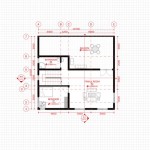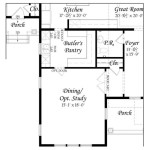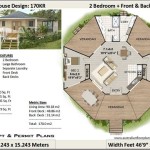How to Draw a Floor Plan of Your House
A floor plan is a top-down view of a house or building, showing the layout of rooms, walls, doors, windows, and other key features. It is a valuable tool for planning renovations, decorating, or simply understanding the spatial arrangement of your home. Drawing a floor plan might seem daunting, but with the right approach and tools, it's a manageable task. This article will guide you through the process step-by-step, providing you with the knowledge and techniques to create a precise and informative floor plan of your house.
1. Gather Supplies and Prepare Your Space
Before you begin drawing, gather the necessary supplies to ensure a smooth and accurate process. You'll need:
-
Measuring tape:
A reliable measuring tape is essential for capturing the accurate dimensions of your house. -
Pencil and eraser:
These are your primary tools for drawing and making corrections. -
Paper or graph paper:
Use paper that's large enough to accommodate the scale of your house. Graph paper can be helpful for maintaining grid-based accuracy. -
Ruler or T-square:
These tools will help you draw straight lines and maintain consistent measurements. -
Protractor:
A protractor is useful for measuring angles, particularly for irregular shapes or angled walls. -
Computer and floor plan software (optional):
If you prefer a digital approach, several floor plan software programs are available, offering user-friendly interfaces and comprehensive options.
Once you have your supplies ready, clear a workspace where you can lay out your paper and comfortably work. You'll also need to access the rooms you're planning to measure. Ensure that the rooms are free of clutter and obstacles that might hinder your measurements.
2. Measure Your House Accurately
Accuracy is paramount when drawing a floor plan. Take your time, double-check your measurements, and record them carefully.
Begin by measuring the overall dimensions of your house. Determine the length and width of the exterior walls. Next, measure the length and width of each room, making sure to note the position of any built-in features like closets, fireplaces, or staircases. Pay attention to the location and size of doors and windows, and record their dimensions.
For rooms with irregular shapes, break them down into smaller, rectangular sections. Measure each section individually and note the angles of any angled walls. Remember to measure the thickness of walls and other structural elements as well. It's helpful to create a simple sketch on paper as you measure, helping you visualize the layout and ensure you haven't missed any measurements.
3. Choose a Scale and Draw the Outline
After gathering your measurements, select a suitable scale for your floor plan. This determines the ratio between the actual dimensions of your house and the size of your drawing. A common scale for residential floor plans is 1/4 inch equals 1 foot, meaning every quarter inch on your drawing represents one foot in reality. You can choose a larger or smaller scale depending on the size of your house and the level of detail you desire.
Once you've chosen a scale, begin drawing the outline of your house. Begin with the exterior walls following the measurements you recorded. Use a pencil to draw these lines, as you may need to make adjustments later. Ensure that the lines are straight and parallel to each other, as this will form the foundation of your floor plan.
4. Add Interior Walls, Doors, and Windows
With the outline of your house complete, start adding interior walls, doors, and windows. Use your measurements and chosen scale to accurately represent these features. Draw walls inside the exterior walls, creating the individual rooms. Draw doors and windows as rectangles, using the correct dimensions and placements according to your measurements.
For doors, use an arrow to indicate the direction they swing. For windows, you can draw a simple grid pattern to represent the glass panes or leave them blank for a more minimalist representation.
5. Include Additional details and Annotations
To make your floor plan more informative, consider adding additional details, such as:
-
Furniture placement:
Draw simple shapes to represent furniture within each room, giving a general idea of layout. -
Appliances:
Include the placement of appliances like ovens, refrigerators, and washers/dryers, using symbols to represent them. -
Stairwells:
Draw the shape of stairwells and indicate the direction of the stairs. -
Light fixtures:
Mark the location of light fixtures or use symbols to represent them. -
Measurements:
Label key measurements for walls, doors, and windows to ensure clarity. -
Legend:
Create a legend explaining the symbols you used in your floor plan. -
North arrow:
Add a north arrow to indicate the orientation of your house.
6. Refine and finalize
Once all the elements are in place, carefully review your floor plan for accuracy and clarity. Make any necessary adjustments to measurements or positions. Erase any unnecessary guidelines or construction lines. Consider using a darker pencil or pen to refine the lines and make your floor plan more legible.
To enhance the visual appeal, you can use different colours or line weights to differentiate between walls, doors, windows, and furniture. If you are using software, you can explore various colour palettes and design options.
Drawing a floor plan of your house is an engaging and informative project. By carefully measuring, planning, and using the techniques outlined in this article, you can create a valuable tool for planning, organizing, and visualizing your home. Remember, accuracy and attention to detail are key, so take your time and enjoy the process.

Floor Plan Creator And Designer Free Easy App

Drawing Up Floor Plans Dreaming About Changes Young House Love

How To Draw House Plans Floor

Floor Plan Creator And Designer Free Easy App

House Plans How To Design Your Home Plan

House Plans How To Design Your Home Plan

How To Draw A Floor Plan The Home Depot

House Plans How To Design Your Home Plan

Plans And Views

How To Read A Floor Plan With Dimensions Houseplans Blog Com
Related Posts








